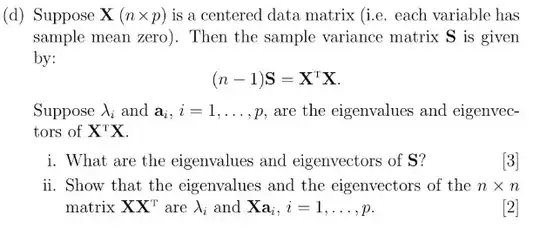In case you are still interested in some answer to your question title, a paper by Paul Henoeine (2014) (link: http://arxiv.org/abs/1407.2904v1) may be of some relevance. In particular, Lemma 1 and Theorem 3 of the paper give relationships in eigenvalues of $X'X$ between centered and non-centered $X$ matrix.
Let $K = X'X$ and $K_c$ = $X_c'X_c$ where $X$ is the nxp matrix and $X_c$ = $(I - \frac {1}{n}11')X$ (i.e., the centered counterpart). Note that $\frac {1}{n}1'X$ = ($\bar x_1$, $\bar x_2$, ..., $\bar x_p$), a row vector of sample means of the p variables, which is denoted as $\mu'$. Conventionally, the eigenvalues are ordered as a decreasing sequence.
Then, the eigen decompositions of $K$ and $K_c$ are $K = A\Lambda A'$ and $K_c = B\Lambda_c B'$, respectively. Note that $\Lambda$ = Diag{$\lambda_i$, i = 1, 2, ..., p }, the diagonal matrix of the eigenvalues of $K$ and $\Lambda_c$ = Diag{$\lambda_{ci}$, i = 1, 2, ..., p }, the diagonal matrix of the eigenvalues of $K_c$. Also, the columns of matrices A and B are the eigenvectors associated with the corresponding eigenvalues.
Applying Lemma 1 of Henoeine (2014), one has the following: $$\sum_{i=1}^p \lambda_{ci} = \sum_{i=1}^p \lambda_{i} - n\mu'\mu$$
Applying Theorem 3, one has the following interlacing property among the eigenvalues: $$\lambda_{cp} \le \lambda_p \le ... \le\lambda_{i+1} \le \lambda_{ci} \le \lambda_{i} \le ...\le \lambda_{2} \le \lambda_{c1} \le \lambda_{1}$$
